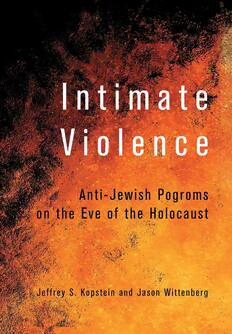
Intimate Violence: Anti-Jewish Pogroms on the Eve of the Holocaust PDF
Preview Intimate Violence: Anti-Jewish Pogroms on the Eve of the Holocaust
INTIMATE VIOL ENCE INTIMATE VIOL ENCE Anti- Jewish Pogroms on the Eve of the Holocaust Jeffrey S. Kopstein and Jason Wittenberg CORNELL UNIVERSITY PRESS ITHACA AND LONDON Copyright © 2018 by Cornell University All rights reserved. Except for brief quotations in a review, this book, or parts thereof, must not be reproduced in any form without permission in writing from the publisher. For information, address Cornell University Press, Sage House, 512 East State Street, Ithaca, New York 14850. First published 2018 by Cornell University Press Printed in the United States of Amer i ca Library of Congress Cataloging- in- Publication Data Names: Kopstein, Jeffrey, author. | Wittenberg, Jason, 1963– author. Title: Intimate vio lence : anti- Jewish pogroms on the eve of the Holocaust / Jeffrey S. Kopstein and Jason Wittenberg. Description: Ithaca : Cornell University Press, 2018. | Includes bibliographical references and index. Identifiers: LCCN 2017048064 (print) | LCCN 2017051368 (ebook) | ISBN 9781501715266 (epub/mobi) | ISBN 9781501715273 (pdf) | ISBN 9781501715259 | ISBN 9781501715259 (cloth : alk. paper) Subjects: LCSH: Jews— Persecutions— Poland— History—20th century. | Pogroms— Poland— History—20th century. | Antisemitism— Poland— History—20th century. | Holocaust, Jewish (1939–1945)— Poland. | Poland— Ethnic relations. Classification: LCC DS134.55 (ebook) | LCC DS134.55 .K68 2018 (print) | DDC 305.892/4043809041— dc23 LC rec ord available at https:// lccn . loc . gov / 2017048064 Cornell University Press strives to use environmentally responsible suppliers and materials to the fullest extent pos si ble in the publishing of its books. Such materials include vegetable- based, low- VOC inks and acid- free papers that are recycled, totally chlorine- free, or partly composed of nonwood fibers. For further information, visit our website at cornellpress . cornell . edu. For Max and Isaac — J.K. For Dahlia — J.W. Contents Preface ix 1. Why Neighbors Kill Neighbors 1 2. Ethnic Politics in the Borderlands 22 3. Mea sur ing Threat and Vio lence 43 4. Beyond Jedwabne 57 5. Ukrainian Galicia and Volhynia 84 6. Pogroms outside the Eastern Borderlands 114 7. Intimate Vio lence and Ethnic Diversity 127 Appendix: Pogroms in the Eastern Borderlands, Summer 1941 137 Notes 143 References 153 Index 167 Preface This book grew out of an invitation to a conference on the Holocaust and its local contexts. Jan Gross’s Neighbors had been published several years earlier and debates continued (and still continue) to rage about who had committed the Jed- wabne pogrom and why. It was an unexpected opportunity to bring together two impor tant streams of scholarship that had never adequately been integrated: the large social scientific lite r a ture on intercommunal vio lence and a new genera- tion of Holocaust historiography that situated the vio lence in specific communi- ties, each with its own backstory. Could the theories and approaches used to ex- plain ethnic vio lence in other contexts help explain the neighbor- on- neighbor vio lence that broke out in hundreds of communities in the eastern Polish bor- derlands as the Germans passed through in summer 1941? Our intuition was that the roots of more than two hundred 1941 pogroms were located in the ethnic demographics and pol iti cal be hav ior of the interwar era, in- formation that we had already been collecting for a proj ect on the ethnic origins of dictatorship and democracy. The historical lit er a ture focuses on anti- Semitism and beliefs about Jewish support for communism. The social science lit er a ture, which does not analyze these pogroms in any detail, suggests the answer lies in the economic and po liti cal threat to pogrom perpetrators by those who would become their victims. Our data could speak to these arguments. We discovered a connection between interwar pol iti cal be hav ior and the occurrence of pogroms that centered on the local pol iti cal milieu and, in part ic u lar, non- Jewish rejec- tion of Jewish efforts to achieve national rights within Poland. We were not working in a vacuum. Other scholars before and during our re- search had already started the slow and painstaking job of documenting pogrom occurrence and nonoccurrence; we supplemented this work with our own ar- chival and secondary research across multiple languages. To this we added our in- terwar census, electoral, and other data. We sought out the expertise of many historians who specialize in Poland and the Holocaust, and the following deserve special mention: Doris Bergen, John Connelly, Sol Goldberg, Antony Polonsky, Anna Shternshis, and Timothy Snyder. We have presented this research at many institutions and conferences and have benefited tremendously from the feedback of our colleagues in po liti cal science, history, and Jewish studies. Data collection is not only tedious, but expensive. We could not have completed this proje ct without generous funding from the National Science Foundation, the
